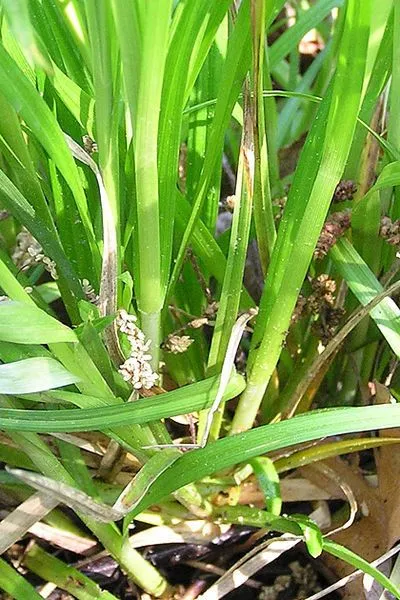
Author: Muhl. ex Willd.
Bibliography: Sp. Pl., ed. 4, 4: 220 (1805)
Year: 1805
Status: accepted
Rank: species
Genus: Carex
Vegetable: False
Observations: SE. Canada to C. & E. U.S.A.
Oval-leaf sedge, scientifically named Carex cephalophora, is a notable species within the Cyperaceae family. This perennial herb is distinguished by its unique oval-shaped leaves, which contribute to its common name. First classified in 1805, this sedge has been a subject of interest in plant taxonomy, thanks to the meticulous work of botanist Muhlenberg, later recognized and documented by Willdenow in the essential botanical volume “Species Plantarum.”
Primarily found across southeastern Canada and the central to eastern regions of the United States, Carex cephalophora inhabits a diverse range of ecosystems. It thrives in both wooded areas and open fields, often favoring well-drained soils and partial to full sunlight. This geographical distribution highlights the plant’s adaptability and ecological value across several climatic zones.
Oval-leaf sedge plays a critical role in its environment, providing habitat and food for various wildlife species. Its dense clumps offer cover for small mammals and birds, while its seeds are a food source for insects and other animals. Additionally, Carex cephalophora contributes to soil health through its deep, fibrous root system, which helps prevent erosion and maintains soil structure.
Recognized for its understated beauty and ecological importance, Oval-leaf sedge continues to be a vital component of North American flora, offering researchers and plant enthusiasts insight into the intricate balance of natural habitats.
Eng: oval-leaf sedge, oval-leaved sedge, oval-headed sedge, short-headed bracted sedge, woodbank sedge
Fra: carex porte-tête
En: Oval-leaf sedge, Oval-leaved sedge, Oval-headed sedge, Short-headed bracted sedge, Woodbank sedge
Fr: Carex porte-tête
Taken Jan 1, 1900 by EOL − USDA NRCS Wetland Science Institute. (public)
Taken May 4, 2010 by EOL − Andrew Hipp (cc-by-nc-sa)
Taken May 4, 2010 by EOL − Andrew Hipp (cc-by-nc-sa)
Taken Jun 4, 2008 by EOL − Chicago Botanic Garden 2008 (cc-by-nc-sa)
Taken May 4, 2010 by EOL − Andrew Hipp (cc-by-nc-sa)
Taken Apr 20, 2010 by EOL − Andrew Gardner (cc-by-nc-sa)
Taken Apr 20, 2010 by EOL − Andrew Gardner (cc-by-nc-sa)
Taken Jan 1, 1900 by EOL − John Hilty (cc-by-nc)
Taken Jun 4, 2008 by EOL − Chicago Botanic Garden 2008 (cc-by-nc-sa)
Taken Apr 20, 2010 by EOL − Andrew Gardner (cc-by-nc-sa)
Taken Apr 20, 2010 by EOL − Andrew Gardner (cc-by-nc-sa)
Taken Jun 4, 2008 by EOL − Chicago Botanic Garden 2008 (cc-by-nc-sa)
Taken Apr 20, 2010 by EOL − Andrew Gardner (cc-by)
Taken Apr 20, 2010 by EOL − Andrew Gardner (cc-by-nc-sa)
Growth form>: Bunch
Growth habit>: Graminoid
Growth rate>: Moderate
Ph maximum: 7.0
Ph minimum: 4.8
Family: Myrtaceae Author: (F.Muell.) K.D.Hill & L.A.S.Johnson Bibliography: Telopea 6: 402 (1995) Year: 1995 Status:…
Family: Rubiaceae Author: Pierre ex A.Froehner Bibliography: Notizbl. Bot. Gart. Berlin-Dahlem 1: 237 (1897) Year:…
Family: Sapindaceae Author: Koidz. Bibliography: J. Coll. Sci. Imp. Univ. Tokyo 32(1): 38 (1911) Year:…
Family: Asteraceae Author: A.Gray Bibliography: Pacif. Railr. Rep.: 107 (1857) Year: 1857 Status: accepted Rank:…
Family: Fabaceae Author: Medik. Bibliography: Vorles. Churpfälz. Phys.-Ökon. Ges. 2: 398 (1787) Year: 1787 Status:…
Family: Aspleniaceae Author: (Cav.) Alston Bibliography: Bull. Misc. Inform. Kew 1932: 309 (1932) Year: 1932…